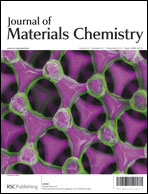A highly sensitive sensor based on hollow particles for the detection, adsorption and removal of Hg2+ ions
Abstract
A simple and facile method has been developed for the preparation of highly sensitive hollow spheric chemosensors. In this method, positively charged polystyrene (PS) particles were employed as templates to prepare silica hollow microspheres, and then the micro-sensors were grafted onto the hollow spheres to obtain hollow-chemosensors. A series of different SiO2 hollow spheres could be prepared by tuning the preparation conditions, and were used to carry the sensors. The hollow-chemosensors could not only detect Hg2+ ions, but were also able to separate them with high efficiency. When the hollow-chemosensors were added to Hg2+ ion solutions, the color of solution instantly changed from red to yellow and could be seen by naked eye. The adsorption capacity did not vary significantly over a wide pH range from 3 to 8. The hollow-chemosensors exhibited high selectivity for the detection of Hg2+ ions over other heavy metal ions. In addition, the superiority of using hollow silica spheres as carriers, which was promising for chemosensor detection, adsorption and removal of heavy metal ions in solution, could be clearly seen.


 Please wait while we load your content...
Please wait while we load your content...